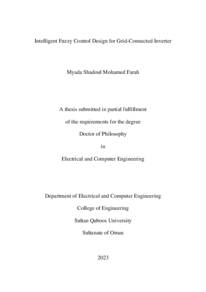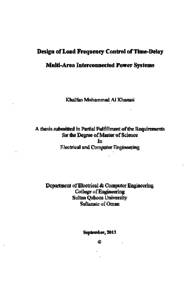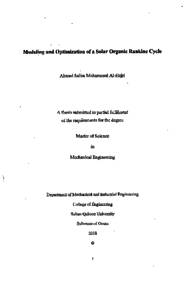Document
Intelligent fuzzy control design for grid-connected inverter.
Other titles
تصميم متحكم ذكي للعاكس المتصل بالشبكة
Publisher
Sultan Qaboos University.
Gregorian
2023
Language
English
English abstract
Nowadays, renewable energy sources (RES) such as photovoltaic (PV) solar systems, wind
turbines, and others are integrated into conventional power systems to avoid the high cost of
constructing new or expanded facilities. The final stage of the integration of PV systems
consists of DC-AC inverters. Three-phase inverters are widely used in grid-connected
renewable energy systems. Grid-connected PV inverter systems are very unpredictable and
nonlinear systems since PV is intermittent and inverters employ Pulse Width Modulation
(PWM) technology. When there is no quick-acting inverter control, these nonlinearities and
uncertainties cause problems with power quality, output harmonics, voltage regulation, losses,
and system implementation.
This research work presents a new intelligent control methodology for PV grid-connected
inverters using type-1 and type-2 adaptive fuzzy control (AFC) techniques. The
implementation of the proposed controller does not need prior knowledge of the system's
mathematical model. The capabilities of the fuzzy system in approximating the nonlinear
functions of the grid-connected inverter system (GCIS) are exploited to design the controller.
The proposed controller is capable of achieving the control objectives in the presence of both
parametric and modelling uncertainties. The closed-loop system stability and the updating laws
of the controller parameters are determined via Lyapunov analysis. The proposed controller is
simulated under different system disturbances, parameters, and modelling uncertainties to
validate the effectiveness of the designed controller. For evaluation, the proposed type-1
controller is compared with a conventional proportional-integral (PI) controller and a Takagi–
Sugeno–Kang-type probabilistic fuzzy neural network controller (TSKPFNN). The results
demonstrated that the proposed AFC showed better performance in terms of response and
reduced fluctuations compared to conventional PI controllers and TSKPFNN controllers. And
the proposed type-2 fuzzy controller is compared to a type-1 fuzzy controller in terms of some
performance measures. The comparison results demonstrate that the proposed type-2 fuzzy
controller has better tracking performance than the type-1 fuzzy controller in terms of the
settling time, the maximum overshoot, the integral absolute error (IAE), and the integral time
of absolute error (ITAE).
Finally, a lab-scale testbed is used for the first time to evaluate the real-time performance
of the proposed adaptive fuzzy controller algorithms for GCISs. In the Hybrid Station Lab at
the Sustainable Energy Research Center of Sultan Qaboos University, experimental validation
was carried out under various operating conditions. The results of the experiments show that
the proposed adaptive fuzzy controller has outstanding tracking capability, quick response
times, and fast convergence of the adaptive parameters.
Member of
Resource URL
Arabic abstract
في الوقت الحاضر، يتم دمج مصادر الطاقة المتجددة مثل أنظمة الطاقة الشمسية الكهروضوئية وتوربينا ت الرياح وغيرها في أنظمة الطاقة التقليدية لتجنب التكلفة العالية لبناء مرافق جديدة أو موسعة. تتكون المرحلة النهائية من تكامل الانظمة الكهروضوئية من محولات تيار ثابت الي تيار متردد. تستخدم المحولات ثلاثية الطور على نطاق واسع في أنظمة الطاقة المتجددة المتصلة بالشبكة. أنظمة العاكس الكهروضوئية المتصلة بالشبكة هي أنظمة ال يمكن التنبؤ بها وغير خطية للغاية حيث إن الطاقة الشمسية متقطعة. عندما ال يكون هناك تحكم سريع المفعول في العاكس، فإن هذه الاخطية تسبب مشاكل في جودة الطاقة، وتنظيم الجهد، وتنفيذ النظام. يعد صنع وحدات تحكم فعالة لألنظمة غير الخطية ذات الخصائص غير المؤكدة أمًرا صعبًا. يقدم هذا البحث طريقة تحكم ذكية جديدة للعاكسات المتصلة بالشبكة الكهروضوئية باستخدام تقنيات التحكم في الضباب التكيفي من النوع 1 والنوع .2 ال يحتاج تنفيذ وحدة التحكم المقترحة إلى معرفة مسبقة بالنموذج الرياضي للنظام. يتم استغالل قدرات النظام الضبابي في تقريب الوظائف غير الخطية لنظام العاكس المتصل بالشبكة لتصميم وحدة التحكم. وحدة التحكم المقترحة قادرة على أهداف التحكم في ظل وجود شكوك معيارية ونمذجة. يتم تحديد استقرار نظام الحلقة المغلقة وقوانين التحديث لمعلمات وحدة التحكم من خلال تحليل Lyapunov. تمت محاكاة وحدة التحكم المقترحة في ظل اضطرابات مختلفة في النظام للتحقق من فعالية وحدة التحكم المصممة. للتقييم، تمت مقارنة وحدة التحكم المقترحة من النوع 1 بوحدات ًء أفضل من حيث الاستجابة وتقلبات أقل مقارنةً تحكم مختلفة. بوحدات أظهرت النتائج أن وحدة التحكم المقترحة أظهر أدا التحكم الاخرى. وتمت مقارنة وحدة التحكم الضبابية المقترحة من النوع 2 بوحدة التحكم الضبابية من النوع 1 من حيث بعض مقاييس الاداء. أظهرت نتائج المقارنة أن وحدة التحكم الغامضة المقترحة من النوع 2 تتمتع بأداء تتبع أفضل من وحدة التحكم الغامضة من النوع .1 أخي ًرا، تم استخدام اختبار على نطاق معملي لأول مرة لتقييم الاداء في الوقت الفعلي لوحدة التحكم الضبابية المقترحة ألنظمة العاكس المتصلة بالشبكة. في معمل المحطة الهجينة في مركز أبحاث الطاقة المستدامة بجامعة السلطان قابوس، تم إجراء الاختبار التجريبي في ظل ظروف تشغيل مختلفة. أظهر نتائج التجارب أن المتحكم المقترح له قدرة تعقب رائعة، وأوقات استجابة سريعة.
Category
Theses and Dissertations



